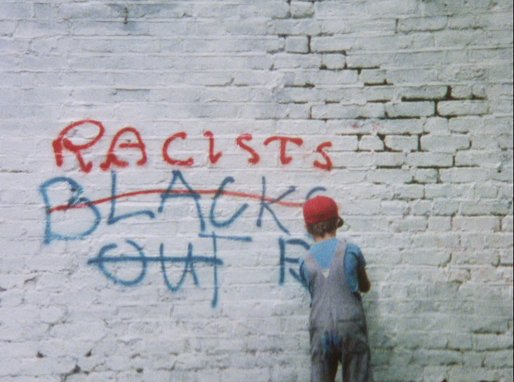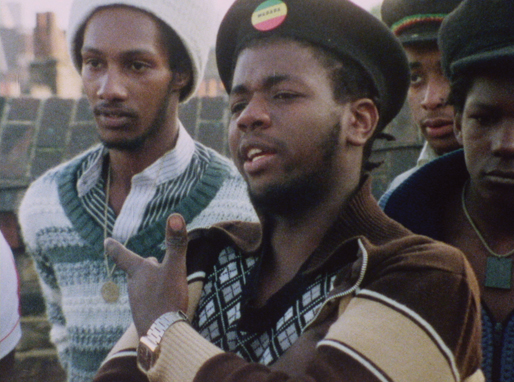By Shane O'Sullivan
Kingston University recently partnered with BFI Education on a new pilot scheme, which challenged first-year filmmaking students on our BA (Hons) Film degree to produce creative responses – in the form of video essays – to one of 12 short documentaries from the BFI National Archive.
By integrating archival representations of London into their own contemporary stories of life in the city today, students gained a unique insight into film and social history while exploring how a ‘punk-infused’ documentary about 1970s racism connects to the current debate on immigration; and how the career prospects for 16-year-old girls have changed since 1963.
The Kingston pilot marks the first time that the BFI has licensed its archive for reuse by university students on a course-related project in the UK. The project grew out of my interest in Paul Gerhardt’s pioneering work to open up creative access to archives – from the Creative Archive pilot he ran at the BBC to his recent initiatives as BFI Director of Education. It was also informed by my own practice as a documentary filmmaker. Creative use of archive footage is integral to the three historical feature documentaries I made before entering academia as a lecturer in filmmaking at Kingston.
After interviewing Gerhardt about his work, I pitched a proposal for the Kingston scheme, inspired by a recent BFI collaboration with BBC Learning. After interviewing World War Two survivors for the BBC social history series Britain’s Greatest Generation (2015), director Steve Humphries (Testimony Films) worked with 7 to eleven-year-olds to make short documentaries, interviewing wartime veterans and illustrating their stories with BFI archive footage.

Divide and Rule - Never! (1978). Image courtesy of BFI National Archive.
While primary and secondary education are the main focus of the BFI’s film literacy strategy, Gerhardt is keen to support initiatives in higher education. BFI Director of Digital, Edward Humphrey, also has plans for a new digital platform like the BFI Player for educational use - a virtual learning environment in which students can download and remix BFI content under an educational licence to create their own films. Both were very interested in a pilot scheme that could test some of these ideas in a university context.
Film theory and practice are equally weighted on our undergraduate Film degree, so the project integrated both aspects of the course, encouraging students to explore questions of racism and immigration across generations using film language to articulate their ideas in video essays through image and sound, rather than just the written word.
How The Pilot Was Run
The pilot ran from January to March 2017, in the second semester of our year-long Documentary Production module. Students made a short documentary on ‘People and Places’ in an assigned London borough for their first assignment. The second brief introduced representation and time by asking students to make a short video essay as a critical and creative response to one of the short documentaries from the BFI collection. Films should be five to ten minutes long, with the amount of archive material used capped at 20 per cent of the running time. End-of-semester assessed presentations charted the research process for each film and the aesthetic choices made as students integrated archive and originally-shot material.
The 12 documentaries I chose from the BFI National Archive are mostly set in London and loosely themed around youth culture and immigration. From the Free Cinema movement of the late 1950s - Nice Time (1957), The Lambeth Boys (1959); to the films of John Krish like Return to Life (1960) and Mr Marsh Comes to School (1962); and Divide and Rule - Never! (1978), which is described by BFI Player as a ‘punk-infused documentary by the Newsreel Collective [which] invites young working class Londoners to discuss their experiences of racism.’
Eight of the films are owned by the BFI or under Crown copyright; four were approved by third-party rightsholders, including Kodak, BP, Southwark Council and Indian filmmaker Vinod Pande, whose London Me Bharat (1972) was the first Hindi-language film made in the UK.
The BFI provided QuickTime ProRes files of the 12 films under a simple licensing agreement for educational and non-commercial use only. Ten of the 12 films were available free online on the BFI Player, so I encouraged students to dip into them over the Christmas holidays.
There was over five hours of archive material so, after introducing the brief in January, I screened a 30-minute taster reel - with two-minute teasers of each of the films - to help students find the inspiration for their projects. I modeled industry practice by asking each group to watch their chosen film on the BFI Player and send me timecodes of the clips they were interested in using. I then gave them watermarked high-resolution clips for their edit.
Students were assessed on their competence in documentary filmmaking techniques; and their ability to tell a story and explore a subject through the editing and juxtaposition of archive and their own original material. I stressed the two features that film theory professor Laura Rascaroli identifies as essential to an essay film: subjectivity - a strong authorial point of view on your subject; and reflectiveness - making sense of the world and thinking through a problem through creative editing of image, sound, voiceover and/or text.

Divide and Rule - Never! (1978). Image courtesy of BFI National Archive.
Three of the nine resulting student films took their inspiration from Divide and Rule - Never!. Newsreel interviews Paul Morrison and Joy Chamberlain, the two surviving members of the collective who made the film. Where is the Love? juxtaposes racist attitudes from the late 1970s with interviews with black and Asian students, Gogglebox-style, exploring their experience of racism today. Stand up to Racism contrasts 1970s activism with an ageing punk’s views at the March Against Racism in March 2017, protesting Trump and Brexit and supporting refugees and migrants in the face of rising intolerance.
Nice Time (2017) contrasts the evening rituals of Piccadilly Circus seen in Nice Time (1957) with nightlife in the West End 60 years later, filtered through the memories of an elderly contributor. The Changing Face of Education compares the career prospects for 16-year-old girls in Peckham – as seen in The Changing Face of Camberwell (1963) - with the opportunities available to female university students today.
Key Lessons Learned
Feedback from students at the end of the module was very positive. They felt the archive-based project was fun, practical and informative, with an interesting selection of films to choose from. The archive material gave them ideas and direction for their films.
Ownership and future use was an issue for some. The BFI archive materials were licensed for classroom use but I told the students upfront that screening their films online would be a subject for negotiation with the BFI and rights holders once the films were completed. Even in a ‘walled garden’ like the BoB service, the existing rights clearance model for educational licensing covers classroom use, not public screening, so new mechanisms are needed to address this.
With first-year students, there was also some initial confusion about the ‘video essay’ aspect of the brief and what kind of film was expected. We took students to a Kogonada masterclass at BFI Southbank early in the year but the increasing popularity of the ‘video essay’ is still largely tied to working with found footage rather than integrating archive and original material.
I think the BFI/Kingston pilot shows that it’s not that difficult to clear a small, curated selection of films across a range of contemporary themes that can stimulate student films and help them engage with film and social history through image and sound. Our students have just completed their films, so once they are assessed and the BFI have evaluated the scheme, I hope we can extend the pilot to other educational institutions across the country.
Shane O’Sullivan
If your institution is interested in participating, please get in touch: S.Osullivan@kingston.ac.uk.
Shane O'Sullivan is Lecturer in Filmmaking at Kingston University and has a professional background in documentary filmmaking. After completing his PhD at Roehampton University in 2013, Shane lectured in filmmaking and film distribution at Regents University and Birmingham City University before his appointment at Kingston in September 2014. The three feature documentaries he has made to date explore contemporary political history and the counter-narratives of several infamous 'enemies of the state'. He is the author of the book Who Killed Bobby? (NYC: Union Square Press, 2008) - based on his documentary RFK Must Die - and has distributed six documentaries in UK cinemas through his production company/DVD label E2 Films.